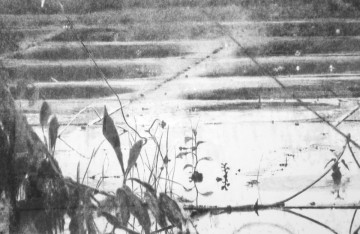Othmar Eder
AM GARTEN VORBEI
May 24, 2013 – July 6, 2013
The turtle in the video ‘Sommer’ that Eder showed last year in the group show ‚Man at work’ was actually the opening line of this show. An endlessly slow camera tracking at turtle eye level through Eder’s garden turned out to be unexpectedly entertaining and exciting although nothing really happened. Just by changing the perspective Eder turned the inconspicuous green from a flat surface into a three dimensional territory to be explored. David Lynch already conveyed in ‘Blue Velvet’ how fast a banal landscape can turn into a site of crime. Eder though ends his search for traces without evidence.
The new two-piece drawing ‘Der Dritte Mann’ (third man) comes like a casual snapshot. Two identical images except for the man that is captured only once. By omitting a figure and concurrently doubling the background Eder creates a dynamic temporal sequence that transforms the distant observer into an unintended witness.
The beginning of the series that had started as a static report of the alpine landscape (‘Über die Berge’) turns now into a tracking of a deceitfully calm territory at the periphery of the beautiful. Joyous goldfinch and Florida palms cannot mislead – the flickering idyll is only superficial. Unspectacular details just like bullet holes and cutout body outlines only increase the visibility of human fractures and chasm. ‘Am Garten vorbei’ is not a romantic stroll and the groggy gnome has not fallen in to a snooze.
Eder proves again to be a sharp observer and creator of multi-layered stories. In ‘Flugzeug mit Vogelschwarm’ (airplane and flock of birds) two individual plots are overlapped and the emerging catastrophe is put on hold. The tender scenery is only delineated and contrasts with the dubious outcome in sight. Did they escape? Passed the garden and on the way into town?
The new two-piece drawing ‘Der Dritte Mann’ (third man) comes like a casual snapshot. Two identical images except for the man that is captured only once. By omitting a figure and concurrently doubling the background Eder creates a dynamic temporal sequence that transforms the distant observer into an unintended witness.
The beginning of the series that had started as a static report of the alpine landscape (‘Über die Berge’) turns now into a tracking of a deceitfully calm territory at the periphery of the beautiful. Joyous goldfinch and Florida palms cannot mislead – the flickering idyll is only superficial. Unspectacular details just like bullet holes and cutout body outlines only increase the visibility of human fractures and chasm. ‘Am Garten vorbei’ is not a romantic stroll and the groggy gnome has not fallen in to a snooze.
Eder proves again to be a sharp observer and creator of multi-layered stories. In ‘Flugzeug mit Vogelschwarm’ (airplane and flock of birds) two individual plots are overlapped and the emerging catastrophe is put on hold. The tender scenery is only delineated and contrasts with the dubious outcome in sight. Did they escape? Passed the garden and on the way into town?


